
Sun Apr 06 - Written by: Denis Maina
12 Genius Landscaping Ideas to Transform Your Small Outdoor Space Into a Dream Garden
As autumn arrives, it's the perfect time to refresh your home with cozy seasonal touches. Why not begin with your bathroom? Introducing fall decor can transform your space into a warm, inviting sanctuary that mirrors the essence of the season.
Living in a small space doesn’t mean you can’t have a stunning outdoor oasis. Whether you’ve got a tiny backyard, a cramped patio or just a sliver of outdoor space you’re looking to transform, there are plenty of ways to make the most of what you’ve got.
Smart landscaping can turn even the tiniest areas into beautiful, functional spaces that feel much bigger than they really are. From vertical gardens that climb up walls to clever container arrangements that maximize every square inch, you’ll find that size limitations can actually spark some pretty amazing creative solutions.
Let’s look at 12 smart and stylish landscaping ideas that’ll help you transform your compact outdoor space into the garden retreat you’ve always wanted. These practical tips work for any small area – whether you’re dealing with a narrow side yard or a pocket-sized patio.
Understanding the Challenges of Small Space Landscaping
Transforming a small outdoor area requires careful planning to maximize every square foot while maintaining visual appeal and functionality.
Common Space Limitations
Small outdoor spaces often present several key challenges that can limit your landscaping options:
- Restricted square footage makes it tough to include multiple features like seating areas patios & plant beds
- Limited sunlight exposure due to tall buildings or neighboring structures affects plant choices
- Narrow pathways & awkward corners create dead spaces that are hard to use
- Privacy concerns from nearby properties or streets require strategic screening solutions
- Storage limitations for gardening tools & outdoor equipment strain available space
- Poor soil conditions in urban settings restrict plant growth & garden bed options
- Drainage issues become more critical in compact spaces where water can pool quickly
Design Principles for Compact Areas
- Create visual layers by using vertical space with wall gardens climbing plants & hanging baskets
- Establish a clear focal point to draw attention & make the space feel more organized
- Use scale-appropriate furniture & features that don’t overwhelm the area
- Incorporate multifunctional elements like storage benches or folding furniture
- Choose a limited color palette to maintain visual harmony & prevent cluttered appearance
- Define zones for different activities using pavers plants or changes in elevation
- Maximize light reflection with light-colored surfaces & mirrors to create depth
- Plan sight lines carefully to create an illusion of more space & maintain flow
- Select dwarf varieties of plants that won’t outgrow their allocated space
Maximizing Vertical Gardens and Living Walls
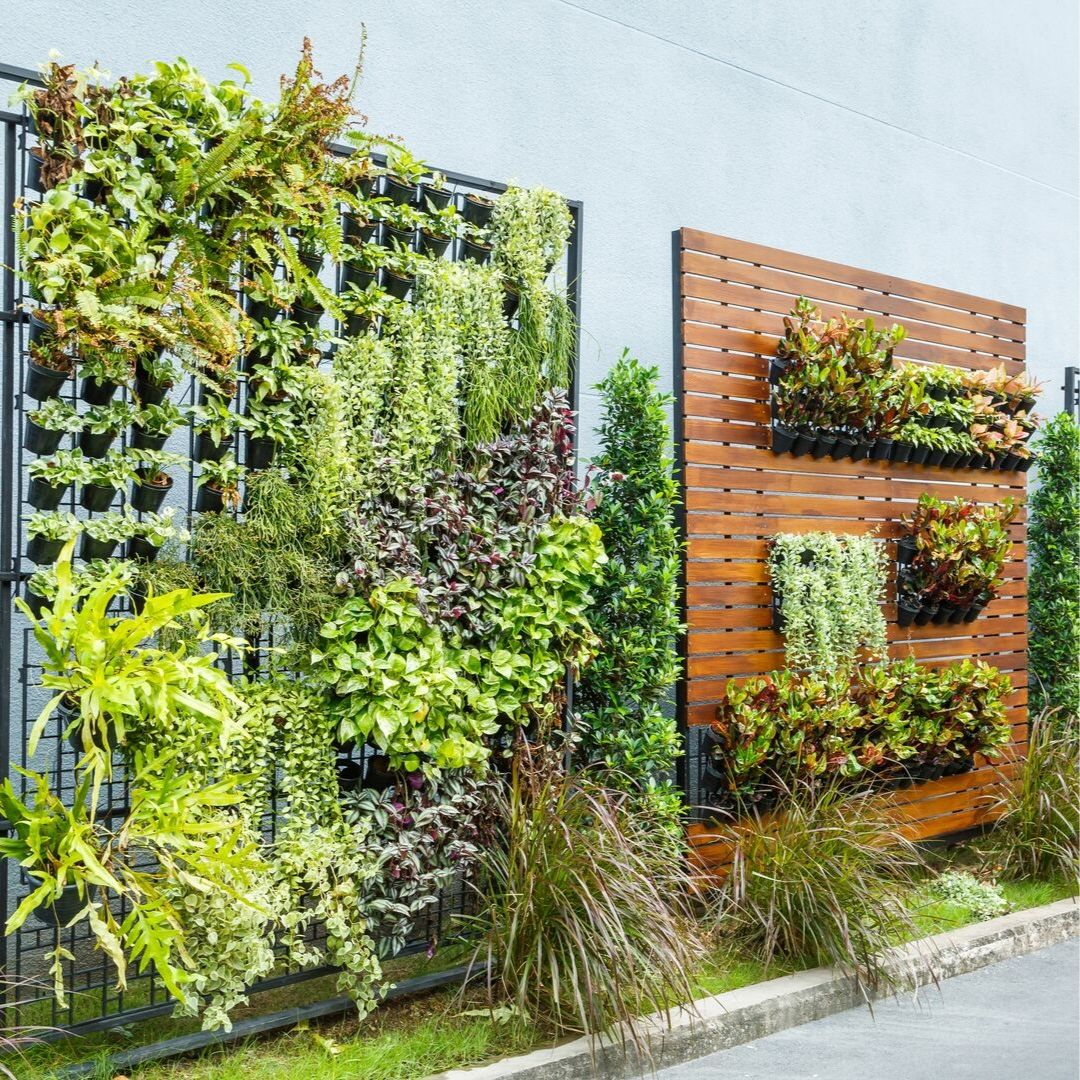 Vertical garden creating a lush green wall in a small space, maximizing plant density without consuming floor area. Source: David Domoney
Vertical garden creating a lush green wall in a small space, maximizing plant density without consuming floor area. Source: David Domoney
Transform your compact outdoor space into a lush oasis by growing upward instead of outward. Vertical gardens make excellent use of limited space while creating stunning visual impact.
Installing Green Wall Systems
Start your vertical garden project by choosing the right support system for your space. Wall-mounted pocket planters offer a simple DIY solution that you can install in just a few hours. For a more sophisticated approach, try modular panel systems that come with built-in irrigation. Here’s what you’ll need:
- A sturdy wall or fence that can support plant weight
- Proper waterproofing to protect your wall structure
- An irrigation system with timer controls
- Multiple planting pockets or modules
- Good drainage collection at the base
Professional installation typically costs $150-400 per square foot, but DIY options start around $50 per square foot.
:max_bytes(150000):strip_icc()/caring-for-vertical-garden-living-wall-getty-0223-2000-9b726eccdfc44f08836d6bf2b4bbf027.jpg) A professionally installed living wall system with built-in irrigation creates dramatic visual impact in a confined space. Source: Martha Stewart
A professionally installed living wall system with built-in irrigation creates dramatic visual impact in a confined space. Source: Martha Stewart
Choosing Plants for Vertical Growth
Select plants that naturally grow upward or cascade downward for the best vertical garden success. Here are top performers for vertical gardens:
- Ferns (Boston Bird’s Nest Spider varieties)
- Succulents (Sedum Burro’s Tail String of Pearls)
- Herbs (Basil Mint Thyme)
- Trailing vines (Pothos Philodendron English Ivy)
- Air plants (Tillandsia varieties)
Mix different textures heights colors to create visual interest. Place drought-tolerant plants at the top where it’s drier sun-loving varieties in brighter spots. Remember to group plants with similar water needs together for easier maintenance.
Creating Multi-Level Garden Terraces
 Multi-level terraced garden beds create distinct planting zones while adding visual interest to a sloped area. Source: Big Living Little Footprint
Multi-level terraced garden beds create distinct planting zones while adding visual interest to a sloped area. Source: Big Living Little Footprint
Transform your compact space into a dynamic landscape by creating different levels that add depth and visual interest while maximizing growing space.
Building Raised Garden Beds
Raised garden beds are perfect for small spaces because they let you control soil quality and create distinct planting zones. Start with beds 4 feet wide or less to ensure easy access from all sides. Stack materials like cedar boards brick or stone blocks to build beds at varying heights (12-36 inches). Add drip irrigation systems during construction to make watering easier. For extra functionality incorporate built-in seating along the edges of taller beds. Choose different bed depths based on your plants: 6-12 inches for herbs 12-18 inches for vegetables and 18-24 inches for small trees or shrubs.
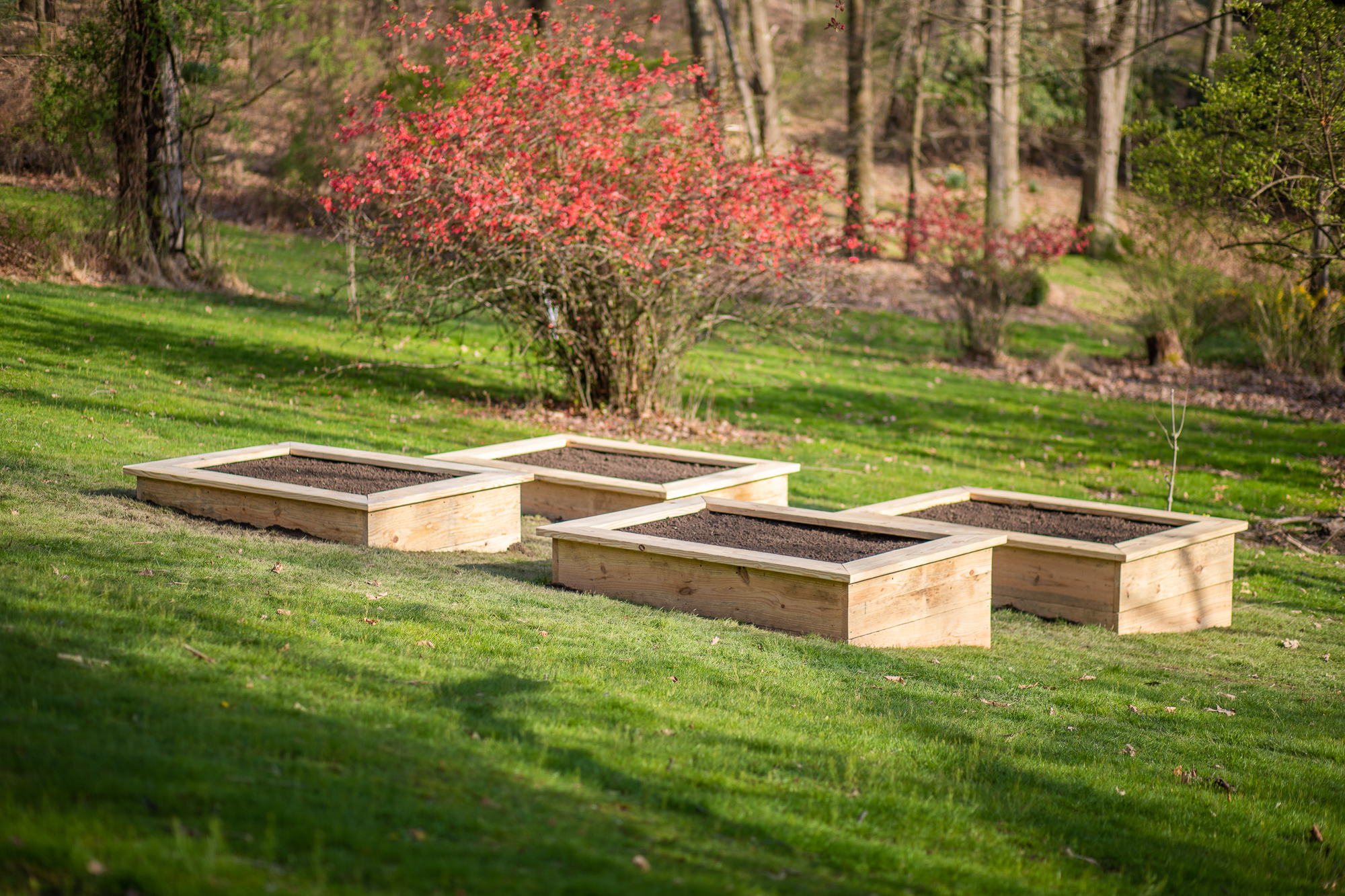 Carefully positioned raised garden beds create depth and structure in this small garden while providing ample growing space. Source: Primal Palate
Carefully positioned raised garden beds create depth and structure in this small garden while providing ample growing space. Source: Primal Palate
Incorporating Step Gardens
Create a striking visual effect by installing tiered garden steps that cascade down your space. Use retaining wall blocks or precast concrete steps to build stable levels 6-8 inches high. Each tier should be at least 12 inches deep to allow proper root growth. Plant low-growing varieties like creeping thyme or sedums between steps to soften edges. Add lighting under each step for dramatic evening effects. Consider installing a small water feature that trickles between levels to create soothing sounds. Space your steps evenly and include small landings every 3-4 tiers for easier maintenance access.
Implementing Space-Saving Container Gardens
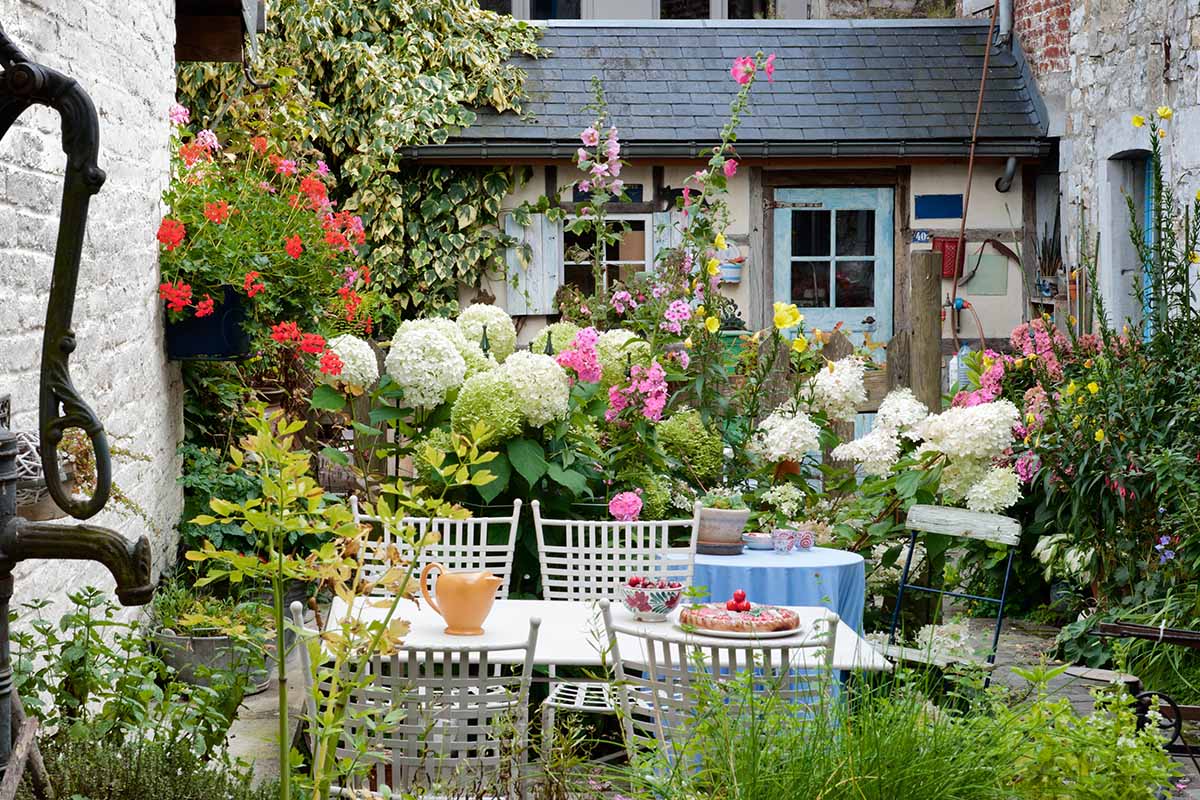 Creative container arrangements using vertical space and various container sizes maximize growing area in this small patio garden. Source: Gardener’s Path
Creative container arrangements using vertical space and various container sizes maximize growing area in this small patio garden. Source: Gardener’s Path
Container gardens offer a versatile solution for compact outdoor spaces letting you maximize growing potential without permanent installations.
Selecting the Right Containers
Choose containers that match your space constraints while providing adequate room for plant growth. Opt for vertical planters stackable pots or wall-mounted containers to save valuable floor space. Self-watering containers work great for busy gardeners while fabric grow bags offer flexibility and proper aeration. For tiny spaces pick narrow window boxes rail planters or hanging baskets that can support trailing plants like petunias strawberries or cascading herbs.
Look for containers with:
- Built-in drainage holes
- Lightweight materials for easy movement
- Weather-resistant construction
- Multiple planting pockets or tiers
- Space-efficient shapes (square or rectangular)
:max_bytes(150000):strip_icc()/mld106425_0311_containrs034_vert-854945533dd24acc858be2751c032119.jpg) Vertical container garden with hanging planters and wall-mounted elements creates a lush display without taking up floor space. Source: Martha Stewart
Vertical container garden with hanging planters and wall-mounted elements creates a lush display without taking up floor space. Source: Martha Stewart
Strategic Container Placement
Map out your container arrangement to maximize both growing space and visual impact. Place larger containers along walls or in corners then layer smaller ones in front creating depth. Hang lightweight planters on fences railings or pergolas to use vertical space. Position containers near seating areas to create natural privacy screens and define outdoor rooms.
- Group containers with similar water needs together
- Arrange by height with tallest at back
- Place frequently harvested plants within easy reach
- Use corners for tiered container displays
- Position containers to catch optimal sunlight
- Create pathways between container groupings for easy access
Designing Folding and Convertible Features
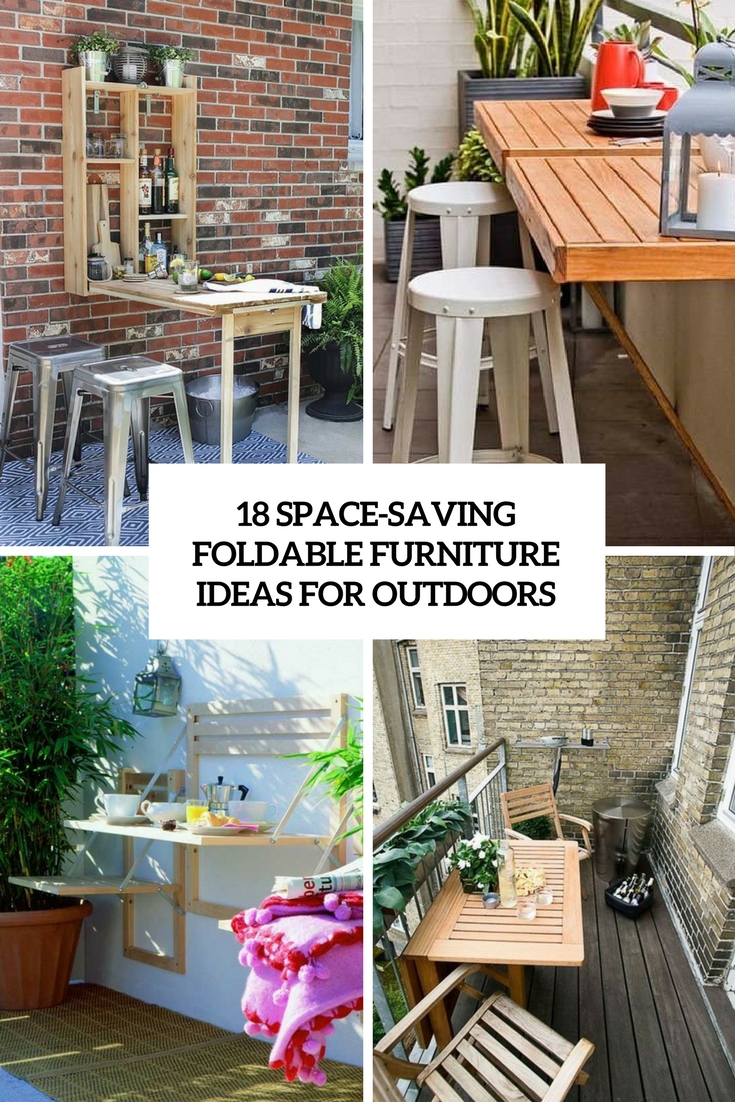 Space-saving folding furniture that can be easily stored when not in use, perfect for compact outdoor areas. Source: Shelterness
Space-saving folding furniture that can be easily stored when not in use, perfect for compact outdoor areas. Source: Shelterness
Transform your compact outdoor space with adaptable elements that can change based on your needs.
Collapsible Furniture Solutions
Maximize your small patio’s potential with smart folding furniture choices. Wall-mounted tables that drop down when needed can create instant dining spaces without permanent footprints. Try bistro-style chairs that fold flat and hang on wall hooks for easy storage. Look for nesting furniture sets that combine multiple pieces like ottomans that slide under coffee tables or stackable side tables that double as extra seating. Consider convertible benches with hidden storage compartments that transform into loungers. Popular options include Murphy-style outdoor bars that fold up against walls and expandable dining sets that accommodate 2-8 people.
 Convertible outdoor daybed with adjustable configurations allows for multiple uses in a small space - from seating to lounging. Source: Amazon
Convertible outdoor daybed with adjustable configurations allows for multiple uses in a small space - from seating to lounging. Source: Amazon
Movable Garden Elements
Make your garden more flexible with portable planters on wheels or casters. These rolling gardens let you adjust your layout based on sunlight patterns or entertainment needs. Try lightweight fabric grow bags that you can easily relocate as seasons change. Install hanging planters on adjustable pulley systems to raise or lower them for maintenance and visual interest. Add modular trellises that can be reconfigured to create different spaces or moved to follow climbing plants’ growth patterns. Consider self-watering containers with handles for easy transport and plant stands with lockable wheels for stability when needed.
Installing a Smart Irrigation System
 Efficient drip irrigation system with thin tubes delivering water directly to plant roots, minimizing waste in a small garden setting. Source: Homestead and Chill
Efficient drip irrigation system with thin tubes delivering water directly to plant roots, minimizing waste in a small garden setting. Source: Homestead and Chill
A smart irrigation system helps you maintain a thriving garden while conserving water in your compact space. Here’s how to set up efficient watering solutions that work in small areas.
Drip Irrigation Networks
Drip irrigation offers precise water delivery directly to plant roots in tight spaces. Install slim irrigation tubes along container edges or beneath mulch to create an invisible watering network. You’ll need a main water line connected to 1/4-inch distribution tubing with adjustable drippers (2-4 gallons per hour) for each plant. Position the drippers 6-12 inches apart for even coverage and wrap the tubing around containers or along bed edges. Add a smart controller to automate watering schedules based on:
- Soil moisture levels
- Local weather data
- Plant-specific needs
- Time of day optimization
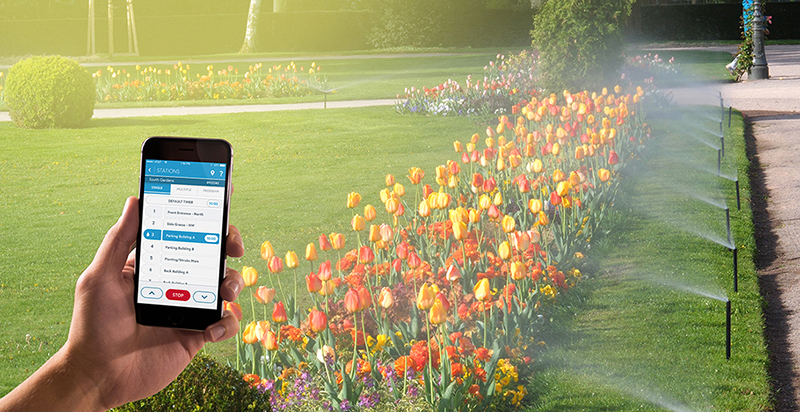 Smart irrigation controller with weather monitoring capabilities allows programming efficient watering schedules via smartphone. Source: HydroPoint
Smart irrigation controller with weather monitoring capabilities allows programming efficient watering schedules via smartphone. Source: HydroPoint
Water-Efficient Solutions
Smart water conservation starts with zone-specific programming for your compact garden’s different areas. Install moisture sensors in key spots to prevent overwatering and connect them to a WiFi-enabled controller for remote monitoring. Choose from these water-saving features:
- Rain sensors that pause irrigation during wet weather
- Flow meters to detect leaks
- Mobile app controls for easy scheduling
- Water usage reports
- Micro-sprayers for hanging baskets
- Self-adjusting programs based on seasonal changes
Add pressure-compensating emitters to maintain consistent flow even in elevated containers or vertical gardens.
Incorporating Multi-Functional Furniture
Smart furniture choices can maximize your compact outdoor space by serving multiple purposes. Here’s how to make every piece work harder for you.
Storage Bench Solutions
Transform your seating area into a practical storage solution with built-in storage benches. These clever pieces offer comfortable seating while hiding away garden tools cushions or outdoor games underneath. Choose weather-resistant materials like teak cedar or powder-coated aluminum for durability. L-shaped corner benches work particularly well in tight spots maximizing seating capacity while using minimal space. Add hinged lids with hydraulic supports for easy access and consider adding weatherproof cushions that can be stored inside when not in use.
 Outdoor storage bench combining comfortable seating with hidden storage space underneath, perfect for small patios and gardens. Source: Amazon
Outdoor storage bench combining comfortable seating with hidden storage space underneath, perfect for small patios and gardens. Source: Amazon
Transformable Garden Features
Make your outdoor furniture work double-duty with pieces that can adapt to different needs. Opt for folding dining tables that can expand for entertaining or collapse when you need more space. Install wall-mounted drop-leaf tables that fold flat against walls when not in use. Consider modular furniture sets that can be arranged as individual chairs or combined into a cozy sofa. Look for nesting side tables that can be tucked away or separated to create multiple surfaces. Add ottomans with removable tops that serve as extra seating storage or casual dining surfaces.
Adding Mirrors and Visual Illusions
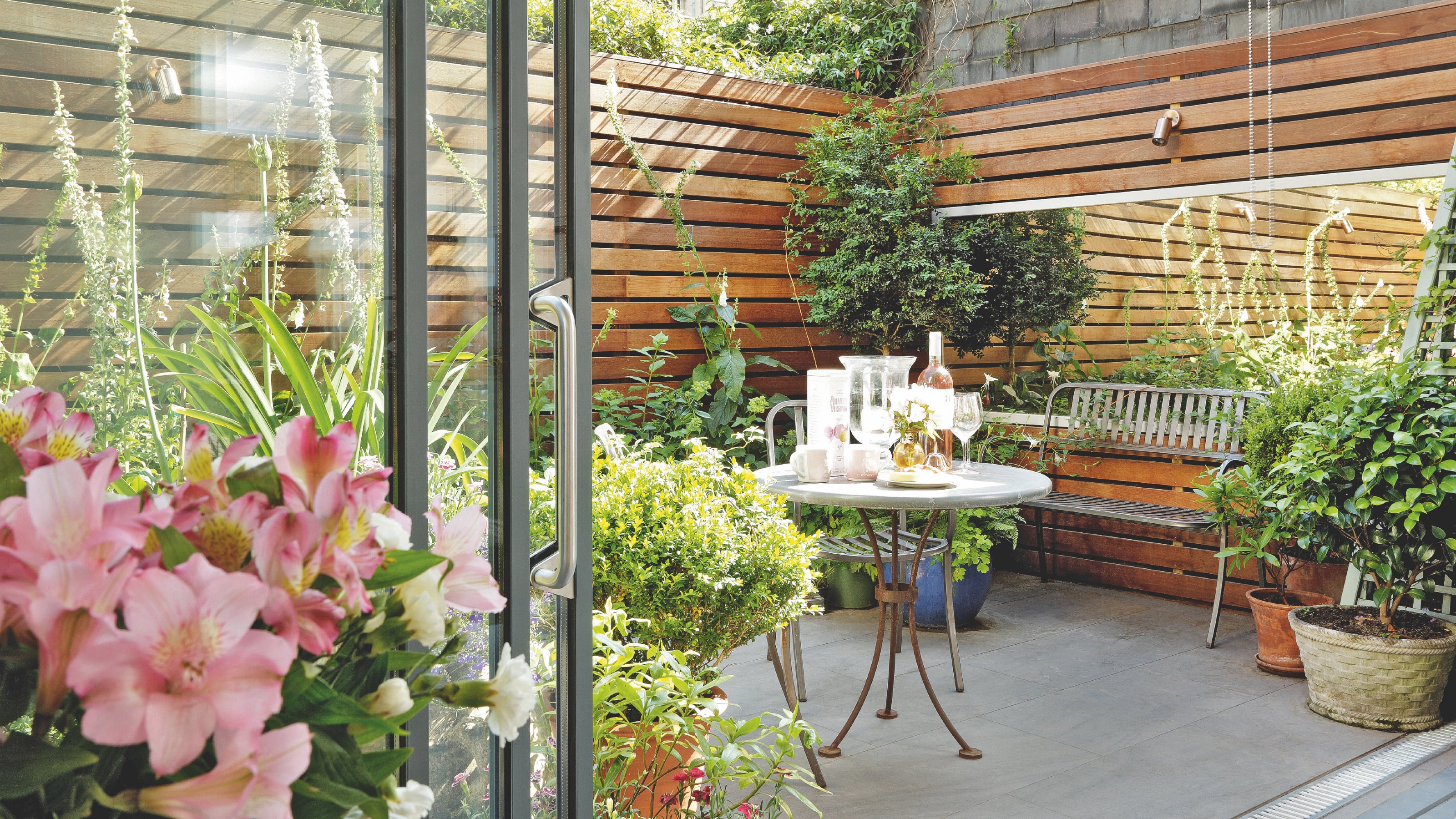 Garden mirror strategically placed to reflect plantings and create the illusion of extended space in a small garden. Source: Ideal Home
Garden mirror strategically placed to reflect plantings and create the illusion of extended space in a small garden. Source: Ideal Home
Transform your compact outdoor space into a seemingly larger oasis using clever visual tricks and strategic mirror placement.
Strategic Mirror Placement
Position weather-resistant mirrors to reflect your garden’s best features while creating an illusion of extended space. Mount them on boundary walls or fences at eye level to capture greenery reflections or frame specific focal points like water features. Choose mirrors with rust-proof frames made from stainless steel or aluminum for durability. Angle your mirrors slightly downward to prevent harsh sun glare and avoid confusing birds. For privacy fences place mirrors behind climbing plants or partially obscure them with container gardens to create subtle depth without revealing neighboring views.
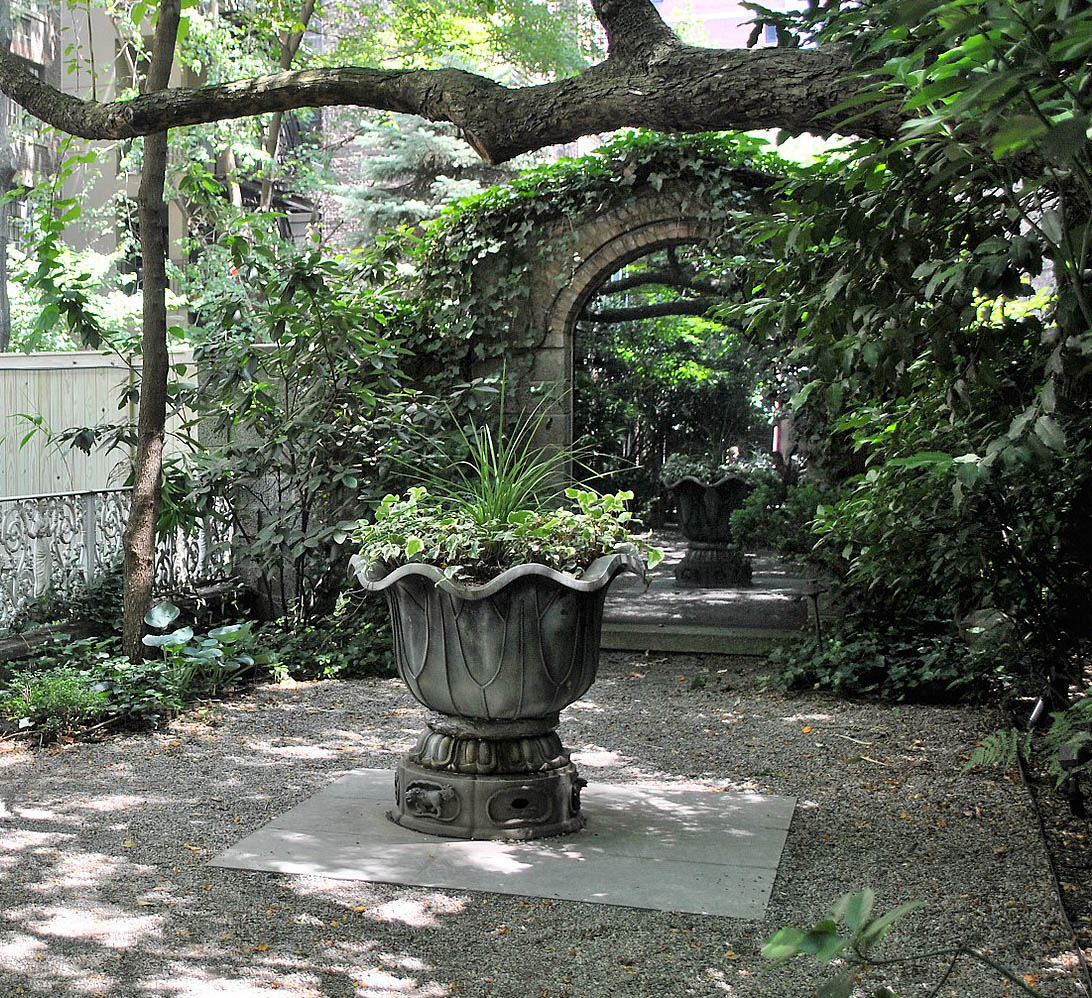 Garden mirror positioned to create the optical illusion of a doorway into another garden space, expanding the perceived area. Source: Improvised Life
Garden mirror positioned to create the optical illusion of a doorway into another garden space, expanding the perceived area. Source: Improvised Life
Creating Depth Through Design
Layer your plantings from low to high to establish a sense of perspective that draws the eye inward. Start with ground covers at the front then add medium-height perennials followed by taller shrubs or small trees at the back. Paint far walls in darker shades to make them recede visually while keeping closer elements in lighter colors. Install diagonal pathways that lead to a focal point like a small fountain or sculpture to create forced perspective. Add lighting at different heights to cast interesting shadows and highlight key features after dark. Use repeating elements like identical planters or matching ornamental grasses to create rhythm and movement through the space.
Utilizing Corner and Dead Space Solutions
:max_bytes(150000):strip_icc()/LifeofIsaTu_-8a367d80e83748f0b749cc57547ccfb8.jpg) Corner garden feature utilizing a traditionally awkward space with layered plantings and decorative elements. Source: The Spruce
Corner garden feature utilizing a traditionally awkward space with layered plantings and decorative elements. Source: The Spruce
Transform those tricky corners and unused areas into vibrant garden features that add character to your compact outdoor space.
Corner Garden Features
Create stunning corner displays by installing triangular raised beds that fit snugly into right angles. Add tiered shelving units designed specifically for corners to display potted plants at various heights. Try a corner trellis that spans both walls meeting at a 90-degree angle to support climbing vines like jasmine or clematis. Install a corner water feature with built-in planters to create a serene focal point that maximizes vertical space. For added functionality incorporate a corner storage bench with a lift-up seat to hide garden tools while providing comfortable seating.
 Corner garden combining a raised bed, water feature, and vertical plantings to transform an otherwise unused corner into a focal point. Source: DigsDigs
Corner garden combining a raised bed, water feature, and vertical plantings to transform an otherwise unused corner into a focal point. Source: DigsDigs
Maximizing Awkward Spaces
Turn narrow side passages into productive herb gardens using mounted wall planters or slim vertical gardens. Transform the space under stairs with shade-loving plants like ferns hostas or Japanese forest grass. Install floating shelves in tight spots between walls to display small succulents or air plants. Use magnetic planters on metal surfaces or stick-on planters for awkward walls where traditional mounting isn’t possible. Add slim bamboo screens or tall ornamental grasses to disguise utility boxes while creating visual interest in otherwise dead zones.
Integrating Compact Water Features
 Compact tabletop fountain with rock formation and recirculating water creates a soothing focal point without requiring much space. Source: Amazon
Compact tabletop fountain with rock formation and recirculating water creates a soothing focal point without requiring much space. Source: Amazon
Transform your small outdoor space with the soothing sounds of water by incorporating these space-conscious water features that create a tranquil atmosphere without overwhelming your limited area.
Mini Fountains and Ponds
You’ll love how tabletop fountains bring instant charm to your compact space while fitting neatly on a small side table or deck railing. Install a self-contained fountain bowl that measures just 18-24 inches across to create a striking focal point without sacrificing precious square footage. Wall-mounted fountains offer another smart solution using vertical space with options like copper spillways or tiered designs that cascade elegantly. For a modern touch try sleek column fountains that stand 3-4 feet tall but maintain a slim 12-inch diameter footprint. These compact water features run on recirculating pumps requiring minimal maintenance while providing maximum impact.
Space-Efficient Water Gardens
Create a stunning water garden using shallow containers just 6-8 inches deep that fit perfectly in tight corners or along narrow pathways. Choose dwarf aquatic plants like miniature water lilies floating heart or water forget-me-nots that thrive in small spaces. Add submerged pots with marginal plants to create different height levels without increasing the footprint. Smart container options include repurposed wine barrels halved whiskey barrels or slim rectangular planter boxes specially designed for aquatic plants. Install simple solar-powered pumps to keep water moving preventing mosquitoes while using minimal energy. Position your water garden where it reflects nearby plants or architectural features to amplify its visual impact.
Planning Small-Scale Lighting Solutions
Transform your compact outdoor space into a magical evening retreat with strategic lighting choices that maximize ambiance without consuming valuable space.
LED Garden Lighting
LED lights offer the perfect solution for small gardens thanks to their compact size and versatility. You’ll find them in various forms like string lights spotlights path markers that can be easily mounted on walls fences or tucked between plants. These energy-efficient lights last up to 50000 hours while producing minimal heat making them safe for placement near delicate plants. Try installing LED strip lights under bench seating or along walkways to create depth without taking up precious space. For vertical interest mount adjustable LED spotlights on walls to highlight architectural features or prized plants while keeping ground space clear.
 LED string lights and strategically placed spotlights create evening ambiance and highlight key features in this small garden. Source: Garden Benches
LED string lights and strategically placed spotlights create evening ambiance and highlight key features in this small garden. Source: Garden Benches
Solar-Powered Options
Solar lights are ideal for compact gardens since they don’t require complex wiring or electrical outlets. You’ll find plenty of slim-profile options like stake lights deck dots and hanging lanterns that charge during the day and illuminate automatically at night. Position solar path lights along narrow walkways or install solar-powered wall sconces to brighten dark corners without running cables. These fixtures work especially well in areas far from power sources saving you the hassle of electrical installation. Many modern solar lights come with motion sensors helping you navigate through tight spaces while conserving battery life.
 Solar-powered garden lights with decorative design illuminate pathways and garden features without requiring electrical wiring. Source: Amazon
Solar-powered garden lights with decorative design illuminate pathways and garden features without requiring electrical wiring. Source: Amazon
Including Space-Efficient Entertainment Areas
Transform your compact outdoor space into a cozy gathering spot with smart entertainment solutions that maximize every square inch.
Intimate Seating Arrangements
Create a snug conversation area with built-in L-shaped benches tucked into corners. Add weatherproof cushions in bright colors to soften the look and provide extra comfort. For flexible seating options go for lightweight folding chairs or stackable stools that you can easily store when not in use. Install wall-mounted drop-leaf tables that fold down when you need extra surface space. Position a small fire pit or tabletop fireplace as your focal point to draw guests together while keeping the arrangement compact and functional.
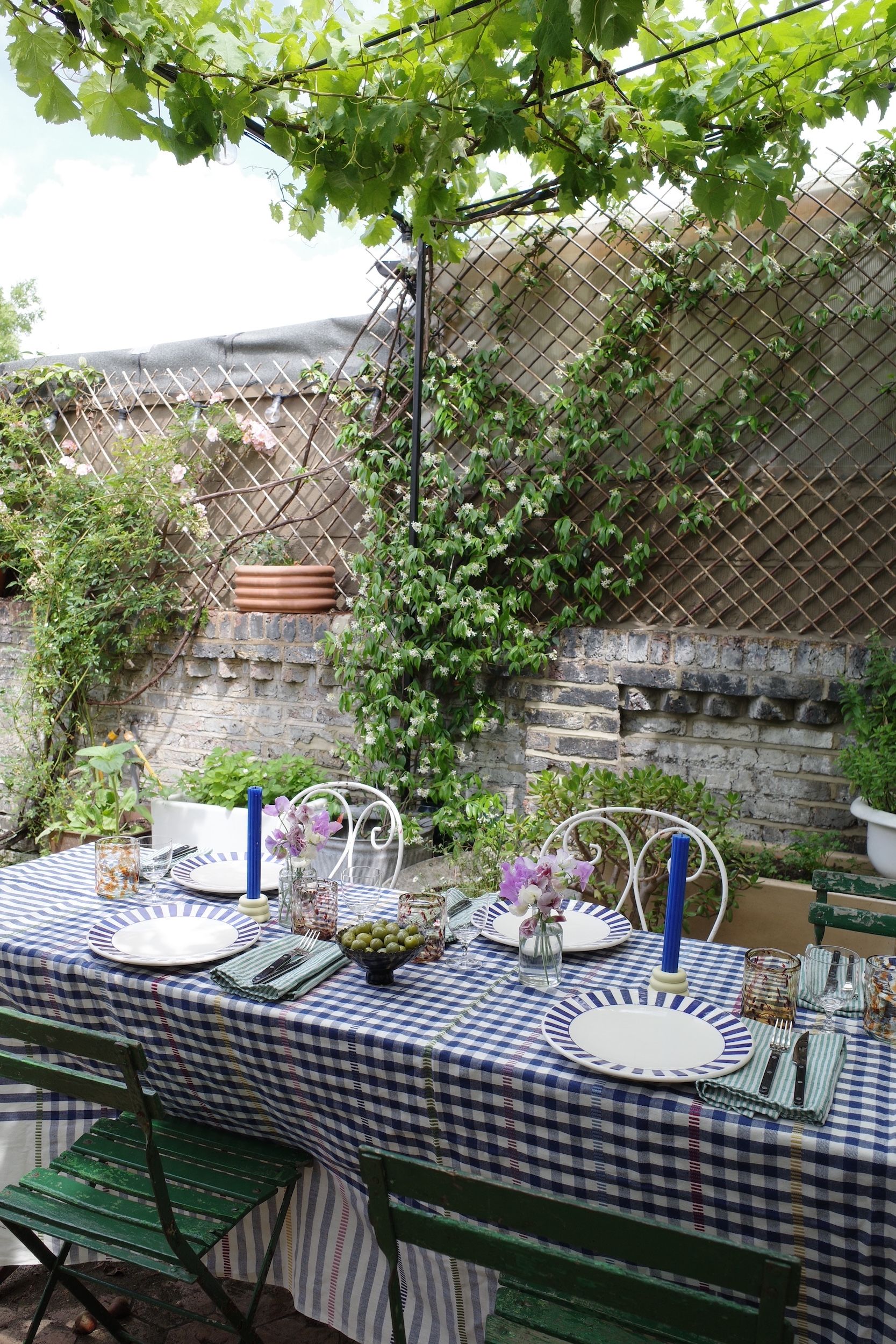 Intimate bistro-style dining setting with minimalist furniture creating a charming entertainment area in a tiny garden space. Source: House Beautiful
Intimate bistro-style dining setting with minimalist furniture creating a charming entertainment area in a tiny garden space. Source: House Beautiful
Compact Outdoor Dining Spaces
Make the most of your tiny dining area with a bistro-style setup using a round table and slim-profile chairs. Choose furniture with clean lines and open designs that won’t overwhelm your space visually. Mount a floating bar counter against the wall that can double as a serving station or casual dining spot. Add wheels to your dining furniture so you can easily move it around when hosting larger gatherings. For extra versatility pick extendable tables that can accommodate more guests when needed but stay compact for daily use.
Conclusion: Bringing Your Small Space Vision to Life
Start with a simple plan and focus on one area at a time. Pick your favorite ideas from these solutions and adapt them to your space’s unique needs. Don’t forget to consider your maintenance capabilities and budget when selecting features. With these creative landscaping solutions, you’ll transform your compact outdoor space into a stunning personal retreat.